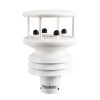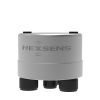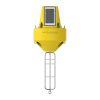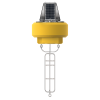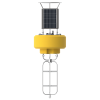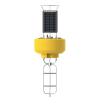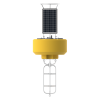Gill MaxiMet Compact Weather Stations
Features
- High quality sensors provide reliable measurements
- Integrated, multi-sensor design reduces deployment cost
- Low power mode for power sensitive applications
- Expedited repair and warranty service
- Lifetime technical support
- More
Overview
The Gill MaxiMet compact weather stations are designed for use on land and marine applications both for stand-alone measurement or integrated into larger systems. The Gill MaxiMet Compact Weather Stations incorporate many measurement parameters required for demanding applications.
Output
Output protocol options for MaxiMet include RS232, RS422, RS485, SDI-12, MODBUS and NMEA, ensuring MaxiMet is easy to install and easy to use. Environmental protection is IP66 across all MaxiMet models. Ultrasonic technology is used in MaxiMet models to deliver highly accurate measurements with no moving parts to wear or recalibrate. As a result, MaxiMet is extremely reliable and low-maintenance.
Available Parameters
- Wind speed and direction
- Air temperature
- Relative/absolute humidity
- Pressure
- Precipitation
- Solar radiation
- GPS coordinates
- MSL (Mean Sea-Level) pressure
- True wind
- Clock
- Longitude and latitude
- Solar noon
- Sunrise
- Sunset twilight
- Ground speed
- Compass
- 2D coordinate/apparent
- Wind
- Location
- Height above sea level
- Averaging (World Meteorological Organization)
- Gust (World Meteorological Organization)
- Air density
- Barometric pressure
- Wet bulb
- Dew point
- Wind chill
- Sensor status information
- Heat index and more
- Gill MaxiMet Compact Weather Station Brochure
- Gill MaxiMet Compact Weather Station Manual
- Gill MaxiMet GMX200 Compact Weather Station Specifications
- Gill MaxiMet GMX240 Compact Weather Station Specifications
- Gill MaxiMet GMX300 Compact Weather Station Specifications
- Gill MaxiMet GMX301 Compact Weather Station Specifications
- Gill MaxiMet GMX400 Compact Weather Station Specifications
- Gill MaxiMet GMX500 Compact Weather Station Specifications
- Gill MaxiMet GMX501 Compact Weather Station Specifications
- Gill MaxiMet GMX600 Compact Weather Station Specifications
In The News
Great Lakes Research Center: Designing Targeted Monitoring Solutions
According to the National Oceanic and Atmospheric Administration ( NOAA ), the Great Lakes have more miles of coastline than the contiguous Atlantic and Pacific coasts combined and contain 20 percent of the world's freshwater, making it a critical region to protect and conserve. Continuous monitoring and data-informed resource management are key components of managing waters in the region. Hayden Henderson, a research engineer with the Great Lakes Research Center (GLRC), designs and deploys monitoring platforms throughout the Great Lakes. With a background in environmental engineering, Henderson enjoyed the challenge of creating systems and making them work to obtain difficult, remote measurements.
Read MoreIt’s Time to React to Water Quality: Proteus Multiparameter Probe aboard NexSens Buoy
Water quality monitoring is essential for safeguarding public health, protecting ecosystems, and ensuring the sustainability of water resources. Contaminants such as industrial pollutants, agricultural runoff, and sewage discharge can severely impact aquatic life and pose serious risks to human health if left unchecked. Traditionally, water quality monitoring has been a slow and labor-intensive process, requiring samples to be collected, transported to a lab, and analyzed—a process that can take days. However, with the advancement of real-time sensor technology, environmental agencies, researchers, and industries can now monitor water quality instantly.
Read MoreSafeguarding Communities with Real-Time Flood Monitoring in the City of Hazelwood
The City of Hazelwood is a suburb in St. Louis County, Missouri, home to around 25,500 people. Recently, the community has suffered increased flash flooding following severe storms, prompting the need for the installation of a flood monitoring system. In 2022, a NexSens X2 data logger was installed to monitor water level and rainfall in real-time, with the aim of reducing the loss of life and property as a result of extreme weather events. [caption id="attachment_39411" align="alignnone" width="940"] The latest flood event at Coldwater Creek, where the water level rose by 14 feet, exceeding the height of the X2 by three feet. The sensor can be seen behind the wall that usually contains the Creek.
Read More




















